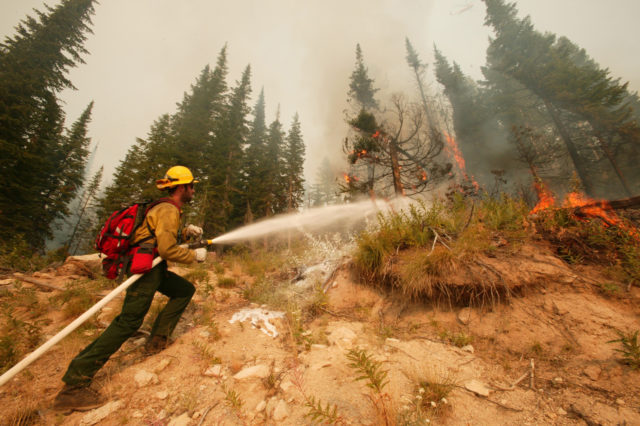Park County, population 15,636, covers 1.7 million acres in south-central Montana, bordered by Yellowstone National Park to the south. The county seat is Livingston, home to 7,000 residents. Other towns include rural communities and gateways to Yellowstone.
 Much of the forested area in the region is lodgepole pine, which is susceptible to intense, stand-replacing fire–fires that are especially dangerous to nearby communities. As the local population grew in the 1990s and early 2000s, developments infringed upon forested areas, putting people and property at greater risk from wildfire.
Much of the forested area in the region is lodgepole pine, which is susceptible to intense, stand-replacing fire–fires that are especially dangerous to nearby communities. As the local population grew in the 1990s and early 2000s, developments infringed upon forested areas, putting people and property at greater risk from wildfire.
In 2006, Park County completed a Community Wildfire Protection Plan (CWPP) meeting the requirements of the 2003 Healthy Forests Restoration Act. The plan includes maps of the wildland-urban interface, fire districts, and fire-risk maps based on historical fire starts, population density, structural density, vegetation, weather, slope, and aspect. The section on structural ignitability focuses on what homeowners can do to reduce risks on their properties.
A 2009 update to the CWPP details the successes of the original 2006 document, including:
- Revision of Park County Subdivision Regulations – requiring new buildings in the wildland-urban interface to include wildfire risk mitigation measures approved by the fire protection authority.
- Hazardous fuels reduction grant assistance program – through a cooperative effort with a local non-profit and a university extension service, 39 fuels reduction projects were completed in Park County, treating almost 97 acres.
- Hazardous fuels reduction projects on National Forest lands – 3,000 acres of National Forest land in Park County were treated for fuels reduction.
- Interagency cooperation – suppression planning and preparedness – the Park County Fire Council meets monthly (with a break during the summer fire season), gathering the county fire warden, local fire chiefs, and representatives from the Park County Sheriff’s Office, 911 Center, Montana Department of Natural Resources and Conservation, National Park Service, and U.S. Forest Service.
- Park County WUI hazardous awareness and risk assessment website – this website includes an interactive risk-assessment questionnaire so that property owners can assess their own fire risk and identify mitigation measures.
- Local suppression preparedness initiatives – the county has updated its communications capabilities through the adoption of a reverse 911 system and modernized radio communications equipment.

The county has not reached other goals set forth in the 2006 CWPP, partly because the recent recession has strained fire resources at local, state, and federal agencies. Despite the county’s efforts, many homeowners do not make efforts to reduce risks of fire on their properties in the wildland-urban interface.
The county continues to provide educational programs in hopes of improving this situation. In addition, the county is trying to improve information on fire history, which could help to produce maps of fire risk that are more accurate and to develop local markets for woody biomass to help reduce fuels accumulations in the forests.
Park County Fire Warden – website
Park County Community Wildfire Protection Plan 2014 Update – PDF
2014 PC CWPP FINAL PDFDownloaded from ResilientWest.org
a project of
Resilient Communities and Watersheds
- Challenges:
- wildfire
- State:
- montana
- Scale:
- site, regional, community, neighborhood
- Type:
- rural
